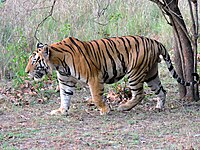
Photo from wikipedia
Abstract Large carnivore populations are globally threatened by human impacts. Better protection could benefit carnivores, co‐occurring species, and the ecosystems they inhabit. The relationship between carnivores and humans, however, is… Click to show full abstract
Abstract Large carnivore populations are globally threatened by human impacts. Better protection could benefit carnivores, co‐occurring species, and the ecosystems they inhabit. The relationship between carnivores and humans, however, is not always consistent in areas of high human activities and is often mediated through the effects of humans on their ungulate prey. To test assumptions regarding how prey abundance and humans affect carnivore occurrence, density, and daily activity patterns, we assessed tiger–prey–human spatiotemporal patterns based on camera‐trapping data in Hunchun Nature Reserve, a promising core area for tiger restoration in China. Our study area contained seasonally varying levels of human disturbance in summer and winter. We used N‐mixture models to predict the relative abundance of ungulate prey considering human and environmental covariates. We estimated tiger spatial distribution using occupancy models and models of prey relative abundance from N‐mixture models. Finally, we estimated temporal activity patterns of tigers and prey using kernel density estimates to test for temporal avoidance between tigers, prey, and humans. Our results show that human‐related activities depressed the relative abundance of prey at different scales and in different ways, but across species, the relative abundance of prey directly increased tiger occupancy. Tiger occupancy was strongly positively associated with the relative abundance of sika deer in summer and winter. The crepuscular and nocturnal tigers also apparently synchronized their activity with that of wild boar and roe deer. However, tigers temporally avoided human activity without direct spatial avoidance. Our study supports the effects of humans on tigers through human impacts on prey populations. Conservation efforts may not only target human disturbance on predators, but also on prey to alleviate human–carnivore conflict.
Journal Title: Ecology and Evolution
Year Published: 2018
Link to full text (if available)
Share on Social Media: Sign Up to like & get
recommendations!